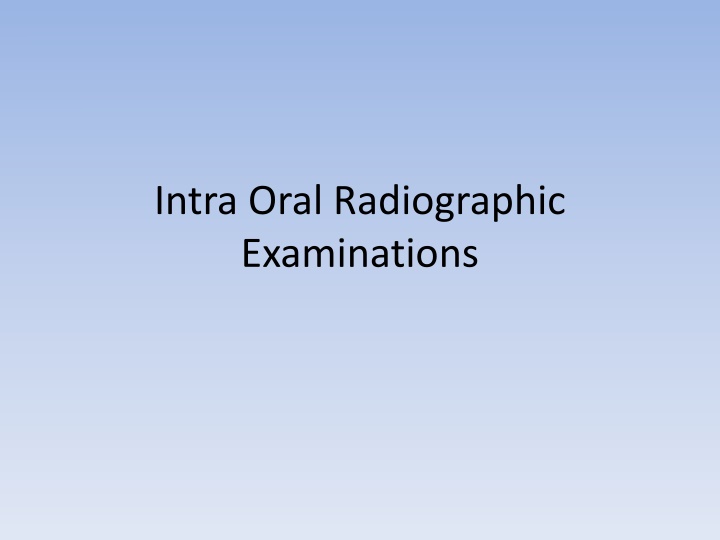
Intraoral Radiographic Examinations and Techniques
Learn about intraoral radiographic examinations, including periapical, bitewing, and occlusal projections. Discover the criteria for quality radiographs, projection techniques, steps for making exposures, and essential angulation of the tube head for accurate imaging.
Download Presentation

Please find below an Image/Link to download the presentation.
The content on the website is provided AS IS for your information and personal use only. It may not be sold, licensed, or shared on other websites without obtaining consent from the author. If you encounter any issues during the download, it is possible that the publisher has removed the file from their server.
You are allowed to download the files provided on this website for personal or commercial use, subject to the condition that they are used lawfully. All files are the property of their respective owners.
The content on the website is provided AS IS for your information and personal use only. It may not be sold, licensed, or shared on other websites without obtaining consent from the author.
E N D
Presentation Transcript
Intra Oral Radiographic Examinations
3 categories Periapical projections Bitewing projections Occlusal projections
Criteria of quality r/g should record the complete areas of interest on the image r/g should have the least possible amount of distortion r/g should have optimal density and contrast to facilitate interpretation
Periapical radiography Projection techniques are: Paralleling technique Bisecting angle
General steps for making an exposure Greet and seat the patient Adjust the x ray unit setting Position the tube head Wash hands thoroughly Examine the oral cavity Position the film Position the x ray tube Make the exposure
Paralleling technique Syn: right angle or long cone technique X ray film is supported parallel to the long axis of teeth Central ray of x ray beam is directed at right angles to the teeth and film This orientation minimizes geometric orientation Use of long source to object distance reduces the apparent size of focal spot
Film holding instruments To position the film parallel to teeth and project periapical areas onto film, position the film away from the teeth and toward the centre of the mouth Commercial instruments: precision instrument XCP instrument with rectangular aiming device
Angulation of tube head Adjust vertical and horizontal planes so that central ray is oriented perpendicular to long axis of teeth and film Vertical angulation: positive or negative degrees Horizontal angulation: influences degree of overlapping of crowns at interproximal spaces Central ray is directed through the contacts in the region being examined
Point of entry maxillary teeth Central incisor - Direct the central ray high on lip, in midline, just below septum of nostril Lateral incisor orient the central ray to enter high on the lip about 1cm from the midline Canine through canine eminence. POI is at the intersection of distal and inferior borders of ala of nose Premolar CR passes through the centre of the 2nd premolar root. Point is usually below pupil of eye
Molar CR should be on the cheek below the outer canthus of eye and zygoma at the position of maxillary 2ndmolar 3rdmolar CR enters the maxillary 3rdmolar region just below the middle of the zygomatic arch, distal to the lateral canthus of the eye
Point of entry mandibular teeth Centrolateral projection CR enters below the lower lip and about 1 cm lateral to midline Canine POI is nearly perpendicular to ala of nose, over the position of canine and about 3cm above inferior border of mandible Premolar CR is below pupil of eye and about 3cm above inferior border of mandible Molar below the outer canthus of eye about 3cm above inferior border of mandible 3rdmolar orient the POI about 3cm above the antegonial notch on the inferior border of mandible, in line with anterior border of ramus
Bisecting angle technique Cieszynski s rule of isometry: 2 triangles are equal when they share one complete side and have 2 equal angles Position the film as close as possible to the lingual surface of teeth, resting in palate or FOM. The plane of film and long axis of teeth form an angle with its apex at the point where the film is in contact with the teeth Construct an imaginary line that bisects this angle and direct the central ray of the beam at right angles to this bisector
This forms 2 triangles with 2 equal angles and a common side Images cast on film are of same length as the projected object Film holding instrument: Snap-A-Ray or bisecting angle instrument Both provide external device for localizing the x ray beam
Position of patient For maxillary arch, patients head should be positioned upright with saggital plane vertical and occlusal plane horizontal For lower arch, head is tilted back slightly to compensate for the changed occlusal plane when the mouth is opened
Angulation guidelines Projection Maxilla Mandible Incisors +40 -15 Canines +45 -20 Premolars +30 -10 Molars +20 -5
Bitewing examinations Syn: interproximal view Includes crowns of maxillary and mandibular teeth and alveolar crest on the film To detect interproximal caries in early stages To detect secondary caries below restorations To evaluate periodontal condition Effective to detect calculus deposits in interproximal areas
Film holding instruments XCP bitewing instrument Film fitted with a tab or loop The beam is angulated +7 to +10 degrees vertically to preclude overlap of the cusps onto the occlusal surface
Occlusal radiograph Displays a relatively large segment of a dental arch Includes the palate or FOM and a reasonable extent of contiguous lateral structures Indications: restricted mouth opening To locate roots and supernumerary, unerupted and impacted teeth To locate foreign bodies in jaws and salivary gland stones To evaluate the integrity of maxillary sinus Location, nature, extent and displacement of fractures of maxilla and mandible To know the medial and lateral extent of disease
Occlusal radiograph The film is inserted between the occlusal surfaces of the teeth Tube side of the film is positioned toward the jaw to be examined and x ray beam is directed through the jaw to the film
Anterior maxillary occlusal projection Image field: the anterior maxilla and its dentition and anterior floor of nasal fossa and teeth from canine to canine CR: through the tip of nose towards the middle of the film with approx 45 degree vertical angle POI: tip of the nose
Cross-sectional maxillary occlusal projection Image field: this view shows the palate, zy processes of maxilla, anteroinferior aspects of each antrum, nasolacrimal canals, teeth from 2ndmolar to 2nd molar and nasal septum CR: at a vertical angle of 65 degree to the bridge of the nose just below the nasion, toward the middle of the film POI: bridge of the nose
Lateral maxillary occlusal projection Image field: shows a quadrant of alveolar ridge of maxilla, inferolateral aspect of antrum, tuberosity, teeth from lateral incisor to contralateral 3rdmolar. Zy process of maxilla superimposes over molar roots CR: vertical angle of 60 degree, to a point 2cm below the lateral canthus of the eye, directed toward centre of film POI: CR enters at a point approx 2 cm below the lateral canthus of the eye
Anterior mandibular occlusal projection Image field: view includes anterior portion of mandible, teeth from canine to canine CR: orient CR with -10 degrees angulation through the point of the chin toward the middle of the film, this gives -55 degree to film plane POI: is in the midline and through the tip of the chin
Cross-sectional mandibular occlusal projection Image field: includes the soft tissues of the FOM, lingual and buccal plates, teeth from 2ndmolar to 2nd molar CR: at the midline, through the floor of mouth approx 3 cm below the chin, at right angles to centre of film POI: is in the midline through the FOM approc 3 cm below the chin
Lateral mandibular occlusal projection Image field: it covers the soft tissues of half of the mouth, both the cortical plates of half of mandible, teeth from lateral incisor to contralateral 3rdmolar CR: direct CR perpendicular to centre of film through a point beneath the chin, approx 3 cm posterior to the point of chin and 3 cm lateral to the midline POI: is beneath the chin, approx 3 cm posterior to the chin and approx 3 cm lateral to the midline






















